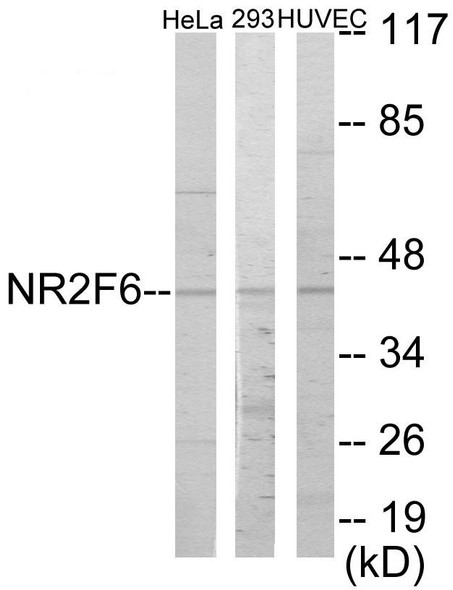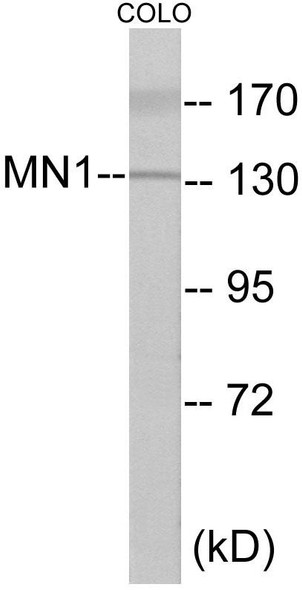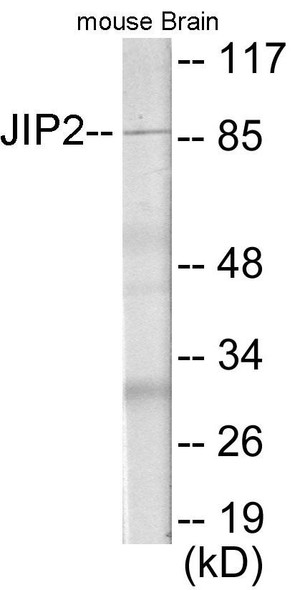ITPK1 Colorimetric Cell-Based ELISA (CBCAB01090)
- SKU:
- CBCAB01090
- Product Type:
- ELISA Kit
- ELISA Type:
- Cell Based
- Reactivity:
- Human
- Mouse
- Detection Method:
- Colorimetric
Description
ITPK1 Colorimetric Cell-Based ELISA
The ITPK1 Colorimetric Cell-Based ELISA Kit is a cutting-edge tool designed for the precise quantification of Inositol-Tetrakisphosphate 1-Kinase 1 (ITPK1) levels in cell lysates and tissue homogenates. This kit offers exceptional sensitivity and specificity, ensuring accurate and reproducible results for a variety of research applications.ITPK1 is a key enzyme involved in inositol phosphate metabolism, playing a crucial role in regulating cell growth, differentiation, and signaling pathways. Dysregulation of ITPK1 has been implicated in various diseases, including cancer, metabolic disorders, and neurological conditions, highlighting its significance as a potential therapeutic target and biomarker.
With the ITPK1 Colorimetric Cell-Based ELISA Kit, researchers can easily study the expression and activity of ITPK1 in different cellular contexts, paving the way for a better understanding of its physiological functions and pathological implications. This advanced assay provides a valuable tool for advancing scientific discoveries and developing novel treatments for ITPK1-related disorders.
| Product Name: | ITPK1 Colorimetric Cell-Based ELISA |
| Product Code: | CBCAB01090 |
| ELISA Type: | Cell-Based |
| Target: | ITPK1 |
| Reactivity: | Human, Mouse |
| Dynamic Range: | > 5000 Cells |
| Detection Method: | Colorimetric 450 nmStorage/Stability:4°C/6 Months |
| Format: | 96-Well Microplate |
The ITPK1 Colorimetric Cell-Based ELISA Kit is a convenient, lysate-free, high throughput and sensitive assay kit that can detect ITPK1 protein expression profile in cells. The kit can be used for measuring the relative amounts of ITPK1 in cultured cells as well as screening for the effects that various treatments, inhibitors (ie siRNA or chemicals), or activators have on ITPK1.
Qualitative determination of ITPK1 concentration is achieved by an indirect ELISA format. In essence, ITPK1 is captured by ITPK1-specific primary antibodies while the HRP-conjugated secondary antibodies bind the Fc region of the primary antibody. Through this binding, the HRP enzyme conjugated to the secondary antibody can catalyze a colorimetric reaction upon substrate addition. Due to the qualitative nature of the Cell-Based ELISA, multiple normalization methods are needed:
| 1. | A monoclonal antibody specific for human GAPDH is included to serve as an internal positive control in normalizing the target absorbance values. |
| 2. | Following the colorimetric measurement of HRP activity via substrate addition, the Crystal Violet whole-cell staining method may be used to determine cell density. After staining, the results can be analysed by normalizing the absorbance values to cell amounts, by which the plating difference can be adjusted. |
| Database Information: | Gene ID: 3705, UniProt ID: Q13572, OMIM: 601838, Unigene: Hs.308122 |
| Gene Symbol: | ITPK1 |
| Sub Type: | None |
| UniProt Protein Function: | ITPK1: Kinase that can phosphorylate various inositol polyphosphate such as Ins(3,4,5,6)P4 or Ins(1,3,4)P3. Phosphorylates Ins(3,4,5,6)P4 at position 1 to form Ins(1,3,4,5,6)P5. This reaction is thought to have regulatory importance, since Ins(3,4,5,6)P4 is an inhibitor of plasma membrane Ca(2+)-activated Cl(-) channels, while Ins(1,3,4,5,6)P5 is not. Also phosphorylates Ins(1,3,4)P3 on O-5 and O-6 to form Ins(1,3,4,6)P4, an essential molecule in the hexakisphosphate (InsP6) pathway. Also acts as an inositol polyphosphate phosphatase that dephosphorylate Ins(1,3,4,5)P4 and Ins(1,3,4,6)P4 to Ins(1,3,4)P3, and Ins(1,3,4,5,6)P5 to Ins(3,4,5,6)P4. May also act as an isomerase that interconverts the inositol tetrakisphosphate isomers Ins(1,3,4,5)P4 and Ins(1,3,4,6)P4 in the presence of ADP and magnesium. Probably acts as the rate-limiting enzyme of the InsP6 pathway. Modifies TNF-alpha-induced apoptosis by interfering with the activation of TNFRSF1A-associated death domain. Belongs to the ITPK1 family. 2 isoforms of the human protein are produced by alternative splicing. |
| UniProt Protein Details: | Protein type:Motility/polarity/chemotaxis; Carbohydrate Metabolism - inositol phosphate; Kinase, lipid; EC 2.7.1.134; EC 2.7.1.159 Chromosomal Location of Human Ortholog: 14q31 Cellular Component: cytosol Molecular Function:catalytic activity; inositol tetrakisphosphate 1-kinase activity Biological Process: blood coagulation; inositol phosphate metabolic process; signal transduction |
| NCBI Summary: | This gene encodes an enzyme that belongs to the inositol 1,3,4-trisphosphate 5/6-kinase family. This enzyme regulates the synthesis of inositol tetraphosphate, and downstream products, inositol pentakisphosphate and inositol hexakisphosphate. Inositol metabolism plays a role in the development of the neural tube. Disruptions in this gene are thought to be associated with neural tube defects. A pseudogene of this gene has been identified on chromosome X. [provided by RefSeq, Jul 2016] |
| UniProt Code: | Q13572 |
| NCBI GenInfo Identifier: | 83288249 |
| NCBI Gene ID: | 3705 |
| NCBI Accession: | Q13572.2 |
| UniProt Secondary Accession: | Q13572,Q9BTL6, Q9H2E7, |
| UniProt Related Accession: | Q13572 |
| Molecular Weight: | 35,632 Da |
| NCBI Full Name: | Inositol-tetrakisphosphate 1-kinase |
| NCBI Synonym Full Names: | inositol-tetrakisphosphate 1-kinase |
| NCBI Official Symbol: | ITPK1 |
| NCBI Official Synonym Symbols: | ITRPK1 |
| NCBI Protein Information: | inositol-tetrakisphosphate 1-kinase |
| UniProt Protein Name: | Inositol-tetrakisphosphate 1-kinase |
| UniProt Synonym Protein Names: | Inositol 1,3,4-trisphosphate 5/6-kinase (EC:2.7.1.159); Inositol-triphosphate 5/6-kinase; Ins(1,3,4)P(3) 5/6-kinase |
| Protein Family: | Inositol-tetrakisphosphate 1-kinase |
| UniProt Gene Name: | ITPK1 |
| UniProt Entry Name: | ITPK1_HUMAN |
| Component | Quantity |
| 96-Well Cell Culture Clear-Bottom Microplate | 2 plates |
| 10X TBS | 24 mL |
| Quenching Buffer | 24 mL |
| Blocking Buffer | 50 mL |
| 15X Wash Buffer | 50 mL |
| Primary Antibody Diluent | 12 mL |
| 100x Anti-Phospho Target Antibody | 60 µL |
| 100x Anti-Target Antibody | 60 µL |
| Anti-GAPDH Antibody | 60 µL |
| HRP-Conjugated Anti-Rabbit IgG Antibody | 12 mL |
| HRP-Conjugated Anti-Mouse IgG Antibody | 12 mL |
| SDS Solution | 12 mL |
| Stop Solution | 24 mL |
| Ready-to-Use Substrate | 12 mL |
| Crystal Violet Solution | 12 mL |
| Adhesive Plate Seals | 2 seals |
The following materials and/or equipment are NOT provided in this kit but are necessary to successfully conduct the experiment:
- Microplate reader able to measure absorbance at 450 nm and/or 595 nm for Crystal Violet Cell Staining (Optional)
- Micropipettes with capability of measuring volumes ranging from 1 µL to 1 ml
- 37% formaldehyde (Sigma Cat# F-8775) or formaldehyde from other sources
- Squirt bottle, manifold dispenser, multichannel pipette reservoir or automated microplate washer
- Graph paper or computer software capable of generating or displaying logarithmic functions
- Absorbent papers or vacuum aspirator
- Test tubes or microfuge tubes capable of storing ≥1 ml
- Poly-L-Lysine (Sigma Cat# P4832 for suspension cells)
- Orbital shaker (optional)
- Deionized or sterile water
*Note: Protocols are specific to each batch/lot. For the correct instructions please follow the protocol included in your kit.
| Step | Procedure |
| 1. | Seed 200 µL of 20,000 adherent cells in culture medium in each well of a 96-well plate. The plates included in the kit are sterile and treated for cell culture. For suspension cells and loosely attached cells, coat the plates with 100 µL of 10 µg/ml Poly-L-Lysine (not included) to each well of a 96-well plate for 30 minutes at 37°C prior to adding cells. |
| 2. | Incubate the cells for overnight at 37°C, 5% CO2. |
| 3. | Treat the cells as desired. |
| 4. | Remove the cell culture medium and rinse with 200 µL of 1x TBS, twice. |
| 5. | Fix the cells by incubating with 100 µL of Fixing Solution for 20 minutes at room temperature. The 4% formaldehyde is used for adherent cells and 8% formaldehyde is used for suspension cells and loosely attached cells. |
| 6. | Remove the Fixing Solution and wash the plate 3 times with 200 µL 1x Wash Buffer for five minutes each time with gentle shaking on the orbital shaker. The plate can be stored at 4°C for a week. |
| 7. | Add 100 µL of Quenching Buffer and incubate for 20 minutes at room temperature. |
| 8. | Wash the plate 3 times with 1x Wash Buffer for 5 minutes each time. |
| 9. | Add 200 µL of Blocking Buffer and incubate for 1 hour at room temperature. |
| 10. | Wash 3 times with 200 µL of 1x Wash Buffer for 5 minutes each time. |
| 11. | Add 50 µL of 1x primary antibodies (Anti-ITPK1 Antibody and/or Anti-GAPDH Antibody) to the corresponding wells, cover with Parafilm and incubate for 16 hours (overnight) at 4°C. If the target expression is known to be high, incubate for 2 hours at room temperature. |
| 12. | Wash 3 times with 200 µL of 1x Wash Buffer for 5 minutes each time. |
| 13. | Add 50 µL of 1x secondary antibodies (HRP-Conjugated AntiRabbit IgG Antibody or HRP-Conjugated Anti-Mouse IgG Antibody) to corresponding wells and incubate for 1.5 hours at room temperature. |
| 14. | Wash 3 times with 200 µL of 1x Wash Buffer for 5 minutes each time. |
| 15. | Add 50 µL of Ready-to-Use Substrate to each well and incubate for 30 minutes at room temperature in the dark. |
| 16. | Add 50 µL of Stop Solution to each well and read OD at 450 nm immediately using the microplate reader. |
(Additional Crystal Violet staining may be performed if desired – details of this may be found in the kit technical manual.)






